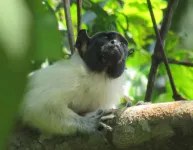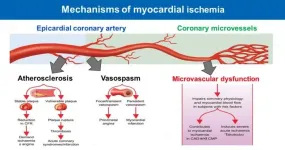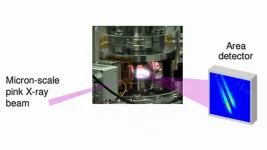(Press-News.org) Each city has its own unique microbiome, a "fingerprint" of viruses and bacteria that uniquely identify it, according to a new study from an international consortium of researchers that included a team from the University of Maryland School of Medicine (UMSOM). The international project, which sequenced and analyzed samples collected from public transit systems and hospitals in 60 cities around the world, was published today in the journal Cell.
The research is considered to be the largest-ever global metagenomic study of urban microbiomes, spanning both the air and the surfaces of multiple cities. It features a comprehensive analysis for all the microbial species identified--including thousands of viruses and bacteria and two newly identified single-cell organisms not found in reference databases.
Study co-author Lynn Schriml, PhD, Associate Professor in the Department of Epidemiology & Public Health, Institute for Genome Sciences (IGS), at UMSOM, led the study sampling efforts for Baltimore's transit systems. "Baltimore's distinct microbial signature reveals a unique, fascinating, and diverse world, providing insights into geographical variation and previously unknown microbial genomes," she said.
Added study senior author Christopher Mason, PhD, a professor at Weill Cornell Medicine and the director of the WorldQuant Initiative for Quantitative Prediction: "Every city has its own 'molecular echo' of the microbes that define it. If you gave me your shoe, I could tell you with about 90 percent accuracy the city in the world from which you came."
The study was conducted before the COVID-19 pandemic shut down cities throughout the world, so the researchers are now looking at how the pandemic affected the microbiome fingerprint of each city. "It's a good question," Schriml said, "and we are address this in follow-up research." The consortium launched the MetaCOV project in 2020 to investigate the change in urban metagenomes and isolate the presence of the SARS-CoV-2 virus (the virus that causes COVID-19) in urban environments (e.g. ATM machines, wastewater, hospitals, transit systems).
Findings in the latest research are based on an analysis of 4,728 samples from cities on six continents taken over the course of three years and represent the first systematic worldwide catalogue of the urban microbial ecosystem. In addition to distinct microbial signatures in various cities, the analysis revealed a core set of 31 species that were found in 97 percent of samples across the sampled urban areas. The researchers identified 4,246 known species of urban microorganisms, but they also found that any subsequent sampling will still likely continue to find species that have never been seen before, which highlights the raw potential for discoveries related to microbial diversity and biological functions awaiting in urban environments.
In the future, the findings also have many potential practical applications including identifying potential new compounds that can be used as antibiotics and small molecules annotated from biosynthetic gene clusters (BGCs) that have promise for drug development.
INFORMATION:
Dr. Schriml joined the International Metagenomics and Metadesign of Subways and Urban Biomes (MetaSUB) consortium in 2016 to gain greater insight on urban built environments through studying the composition and variation of microbes across Baltimore and Washington D.C. mass transit systems. The MetaSUB consortium has expanded since then to include projects sampling diverse built environments including sewers, monuments and hospitals with Dr. Schriml sampling biofilms on the Orpheus Monument at Fort McHenry and the Soldiers' National Monument at Gettysburg in 2018. She had been joined by study co-author Emmanuel Mongodin, PhD, former Assistant Professor of Microbiology and Immunology at UMSOM and IGS faculty member. Last year he left UMSOM to become a program director at the National Heart, Lung, and Blood Institute.
About the University of Maryland School of Medicine
Now in its third century, the University of Maryland School of Medicine was chartered in 1807 as the first public medical school in the United States. It continues today as one of the fastest growing, top-tier biomedical research enterprises in the world -- with 45 academic departments, centers, institutes, and programs; and a faculty of more than 3,000 physicians, scientists, and allied health professionals, including members of the National Academy of Medicine and the National Academy of Sciences, and a distinguished two-time winner of the Albert E. Lasker Award in Medical Research. With an operating budget of more than $1.2 billion, the School of Medicine works closely in partnership with the University of Maryland Medical Center and Medical System to provide research-intensive, academic and clinically based care for nearly 2 million patients each year. The School of Medicine has more than $563 million in extramural funding, with most of its academic departments highly ranked among all medical schools in the nation in research funding. As one of the seven professional schools that make up the University of Maryland, Baltimore campus, the School of Medicine has a total population of nearly 9,000 faculty and staff, including 2,500 student trainees, residents, and fellows. The combined School of Medicine and Medical System ("University of Maryland Medicine") has an annual budget of nearly $6 billion and an economic impact more than $15 billion on the state and local community. The School of Medicine, which ranks as the 8th highest among public medical schools in research productivity, is an innovator in translational medicine, with 600 active patents and 24 start-up companies. The School of Medicine works locally, nationally, and globally, with research and treatment facilities in 36 countries around the world. Visit medschool.umaryland.edu
New research has discovered that monkeys will use the "accent" of another species when they enter its territory to help them better understand one another and potentially avoid conflict.
Published in the journal Behavioral Ecology and Sociobiology, the study is the first to show asymmetric call convergence in primates, meaning that one species chooses to adopt another species' call patterns to communicate.
The study, co-authored by Dr Jacob Dunn of Anglia Ruskin University (ARU), investigated the behaviour of 15 groups of pied tamarins (Saguinus bicolor) and red-handed tamarins (Saguinus midas) in the Brazilian Amazon.
Pied tamarins are critically endangered and have one of the smallest ...
For the first time, a prospective, international study has shown that chest pain caused by problems with the very small vessels supplying blood to the heart is an important health problem that increases the risk of heart attacks, stroke and death due to cardiovascular reasons.
The study, which is published today (Thursday) in the European Heart Journal [1], recruited 686 patients from 14 institutions in seven countries on four continents [2] between July 2015 and December 2018 to investigate microvascular angina (MVA). Until now, MVA was widely thought to be a benign disease that mainly occurs in women. However, the ...
Half a billion tonnes of carbon emissions could be cut from Earth's atmosphere by improved management of peatlands, according to research partly undertaken at the University of Leicester.
A team of scientists, led by the UK Centre for Ecology and Hydrology (UKCEH), estimated the potential reduction of around 500 million tonnes in greenhouse gas (GHG) emissions by restoring all global agricultural peatlands.
Peatlands - a type of wetland, where dead vegetation is stopped from fully breaking down - cover just 3% of the global land surface, but store around 650 billion tonnes of ...
Highlights
Among patients receiving dialysis in the Southeastern United States, those at for-profit dialysis facilities were less likely to be referred for kidney transplantation than those at non-profit facilities.
Rates of starting medical evaluations soon after referral and placing patients on a waitlist after evaluations were similar between the groups.
Washington, DC (May 26, 2021) -- New research indicates that patients with kidney failure who receive care at for-profit dialysis facilities are less likely to be referred for kidney transplants that those receiving care at non-profit ...
Scientists at the Centro Nacional de Investigaciones Cardiovasculares (CNIC) have identified the first blood biomarker for myocarditis, a cardiac disease that is often misdiagnosed as myocardial infarction. Nevertheless, the diagnosis of myocarditis continues to be challenging in clinical practice.
The study, led by Dr. Pilar Martín and published today in The New England Journal of Medicine, has detected the presence of the human homolog of micro RNA miR-721 in the blood of myocarditis patients.
CNIC General Director Dr. Valentín Fuster emphasizes that these results of paramount importance because they establish the first validated blood marker with high sensitivity and specifity (>90%) for myocarditis. This will allow ...
Continuous skin-to-skin contact starting immediately after delivery even before the baby has been stabilised can reduce mortality by 25 per cent in infants with a very low birth weight. This according to a study in low- and middle-income countries coordinated by the WHO on the initiative of researchers at Karolinska Institutet published in The New England Journal of Medicine.
Continuous skin-to-skin contact between infant and mother, or "Kangaroo Mother Care" (KMC), is one of the most effective ways to prevent infant mortality globally. The current recommendation from the World Health Organization (WHO) is that skin-to-skin contact should commence ...
ITHACA, N.Y. - Soil carbon storage, carbon capture and storage, biochar - mention these terms to most people, and a blank stare might be the response.
But frame these climate change mitigation strategies as being clean and green approaches to reversing the dangerous warming of our planet, and people might be more inclined to at least listen - and even to back these efforts.
A cross-disciplinary collaboration led by Jonathon Schuldt, associate professor of communication at Cornell University, found that a majority of the U.S. public is supportive of soil carbon storage as a climate change mitigation strategy, particularly when that and similar approaches are seen as "natural" strategies.
"To me, that psychology part - that's really interesting," Schuldt ...
With brilliant colors and picturesque shapes, many crystals are wonders of nature. Some crystals are also wonders of science, with transformative applications in electronics and optics. Understanding how best to grow such crystals is key to further advances.
Scientists from the U.S. Department of Energy's (DOE) Argonne National Laboratory, along with three universities, have revealed new insights into the mechanism behind how gallium nitride crystals grow at the atomic scale.
Gallium nitride crystals are already in wide use in light-emitting diodes, better known as LEDs. They might also be applied to form transistors for high-power switching electronics to make electric grids more energy efficient and smarter. The use of such "smart grids," which ...
The opioid epidemic is taking a deadly toll on people in disproportionate clusters from Cape Cod to San Diego, according to a new study by the University of Cincinnati.
Fatal opiate overdoses are most prevalent among six states: Ohio, Pennsylvania, Kentucky, West Virginia, Indiana and Tennessee. But researchers identified 25 hot spots of fatal opioid overdoses nationwide using data from the Centers for Disease Control and Prevention.
The study demonstrates how both widespread and localized the problem of substance use disorders can be, UC assistant professor and co-author Diego Cuadros ...
What is happening deep beneath the surface of ice planets? Is there liquid water, and if so, how does it interact with the planetary rocky "seafloor"? New experiments show that on water-ice planets between the size of our Earth and up to six times this size, water selectively leaches magnesium from typical rock minerals. The conditions with pressures of hundred thousand atmospheres and temperatures above one thousand degrees Celsius were recreated in a lab and mimicked planets similar, but smaller than Neptune and Uranus.
The mechanisms of water-rock interaction at the Earth's surface are well known, and the picture of ...





